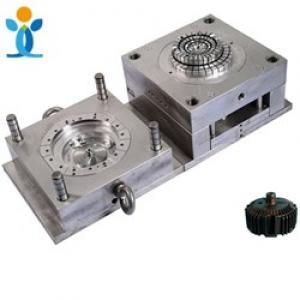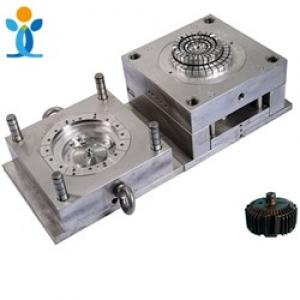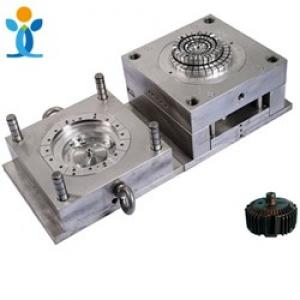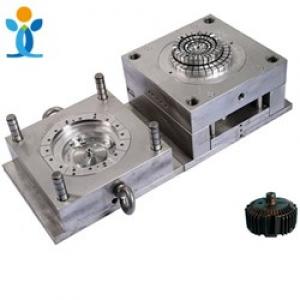4 elements for burining marks of injection parts
4 elements for burining marks of injection parts
Factor 1: melt fracture
When the melt is injected into the cavity with large volume at high speed and high pressure, it is easy to produce melt fracture. At this time, the melt surface appears transverse fracture, and the fracture area is rough mixed in the surface of the plastic part to form paste spots. Especially when a small amount of melt is directly injected into the mold cavity which is easy to be too large, the melt fracture is more serious, and the larger the paste spot is.The essence of melt fracture is due to the elastic behavior of polymer melt. When the melt flows in the barrel, the melt near the barrel is abraded by the wall of the barrel. The stress is large and the flow speed of the melt is small. Once the melt is injected from the nozzle, the stress acting on the wall of the tube is eliminated, while the flow speed of the melt in the middle of the barrel is very high. The melt in the barrel is carried by the melt in the center As the melt flow is relatively continuous, the internal and external melt flow speed will rearrange to the average speed.
In this process, the melt will have a sharp change in stress, which will produce strain. Because of the extremely fast injection speed, the stress received is particularly large, which is far greater than the strain capacity of the melt, leading to melt fracture.
If there are sudden shape changes in the flow channel, such as diameter shrinkage, expansion and dead angle, the molten material stays and circulates at the dead angle. It is different from the normal molten material in stress, and the shear deformation is large. When it is mixed into the normal molten material and injected out, because the deformation recovery of the two is inconsistent, it cannot be bridged. If there is a large difference, it will break, and its manifestation is also It's a melt fracture.
It can be seen from the above that to overcome the fracture of trapped melt and avoid the generation of paste spots:
Pay attention to eliminate the dead angle in the flow passage to streamline the flow passage as much as possible;
increase the material temperature properly, reduce the relaxation time of the melt, and make the deformation easy to recover and close;
The lower the molecular weight is, the wider the distribution is, and the less the elastic effect is;
Proper control of injection speed and screw speed;
It is very important to set the gate position reasonably and choose the correct gate form. The practice shows that it is ideal to adopt the enlarged point gate and the latent gate (tunnel gate). It is better to choose the gate position when the melt is first injected into the transition cavity and then into the larger cavity, so as not to let the flow material directly into the larger cavity.
Factor 2: improper control of forming conditions
This is also an important reason for scorch and paste spots on the surface of plastic parts, especially the injection speed has a great influence on it. When the flow material is injected into the cavity slowly, the flow state of the melt is laminar; when the injection speed rises to a certain value, the flow state gradually becomes turbulent.
Generally, the surface of the plastic part formed by laminar flow is bright and flat, and the plastic part formed by turbulent flow is not only prone to paste spots on the surface, but also prone to air holes inside the plastic part. Therefore, the injection speed should not be too high, the flow material should be controlled in the laminar flow state.
If the temperature of the melt is too high, it is easy to cause decomposition and coking of the melt, resulting in paste spots on the surface of the plastic parts. In general, the screw speed of injection molding machine should be less than 90r / min, and the back pressure should be less than 2MPa, so as to avoid excessive friction heat of the barrel.
If excessive friction heat is produced due to too long rotation time when the screw is returned in the forming process, it can be overcome by properly increasing the screw speed, prolonging the forming period, reducing the screw back pressure, increasing the temperature of the feeding section of the barrel and using raw materials with poor lubricity.
During the injection process, too much refluxing along the screw groove and resin retention at the check ring will lead to the depolymerization of the melt. Therefore, the resin with high viscosity should be selected, the injection pressure should be reduced properly, and the injection molding machine with large length diameter ratio should be used instead. The check rings commonly used in injection molding machines are easy to cause retention, which makes them decompose and discolor. When the decomposed discolored melted material is injected into the cavity, it will form a brown or black focus. In this regard, the screw system centered on the nozzle should be cleaned regularly.
Factor 3: mold failure
If the vent hole of the mold is blocked by the release agent and the solidified substance separated from the raw material, the exhaust setting of the mold is not enough or the position is not correct, and the filling speed is too fast, the high temperature gas produced by the adiabatic compression of the air in the mold which is too late to be discharged will make the resin decompose and coking. In order to solve this problem, it is necessary to remove the obstruction, reduce the closing force and improve the poor exhaust of the mould.
It is also very important to determine the form and position of the mold gate. The flow state of the melt and the exhaust performance of the mold should be fully considered in the design.
In addition, the amount of mold release agent should not be too much, and the surface of the cavity should maintain a high degree of finish.
Factor 4: raw materials do not meet the requirements
If the content of water and volatile matter in raw materials is too high and the melt index is too large, the excessive use of lubricants will lead to scorch and smudge failure.
In this regard, hopper dryer or other pre drying methods should be used to deal with raw materials, to replace resin with smaller melt index and to reduce the amount of lubricant





